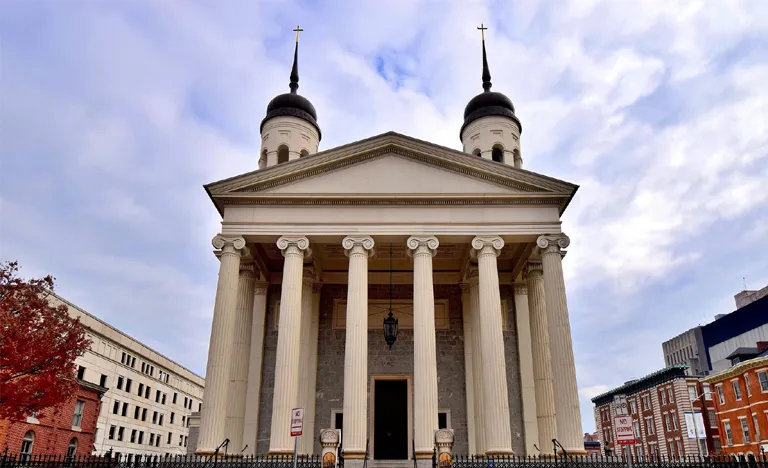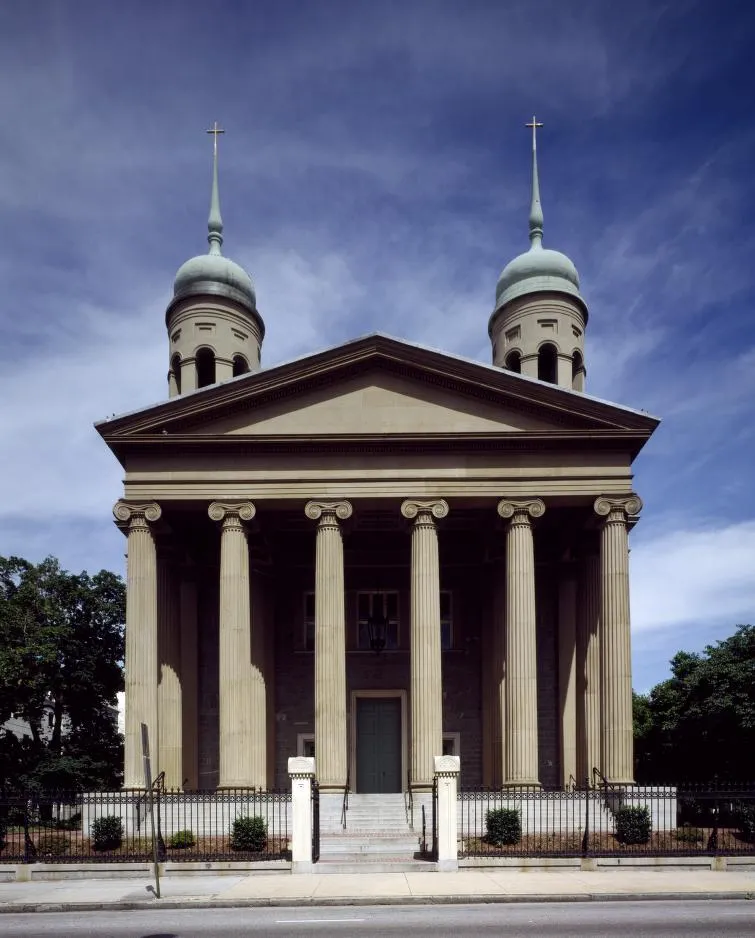
Introduction
The Baltimore Basilica, also known as the Basilica of the National Shrine of the Assumption of the Blessed Virgin Mary is a Catholic cathedral in Baltimore, Maryland. It was the first Catholic cathedral built in the United States after the nation’s founding, and was among the first major religious buildings constructed therein after the adoption of the U.S. Constitution. As a co-cathedral, it is one of the seats of the Catholic Archdiocese in Baltimore, Maryland. Additionally it is a parish church (ranked minor basilica) and national shrine. It is considered the masterpiece of Benjamin Henry Latrobe, the “Father of American Architecture”.
The Baltimore Basilica was constructed between 1806 and 1821. It was designed by Benjamin Henry Latrobe, the first professionally trained architect in the U.S. and called the “Father of American Architecture.” He also designed the U.S. Capitol in Washington, D.C. and the porticos of the White House. The Baltimore Basilica was raised to the rank of a Minor Basilica in 1937.
With a history that spans centuries, Baltimore Basilica has been witness to some of the most significant events in American Catholic history. It’s a symbol of religious freedom and pride for Catholics in America. The design of this magnificent building was influenced by none other than Thomas Jefferson himself. As America’s first cathedral, Baltimore Basilica was envisioned, designed, and constructed based on American principles of architecture – not European, and certainly not Gothic.
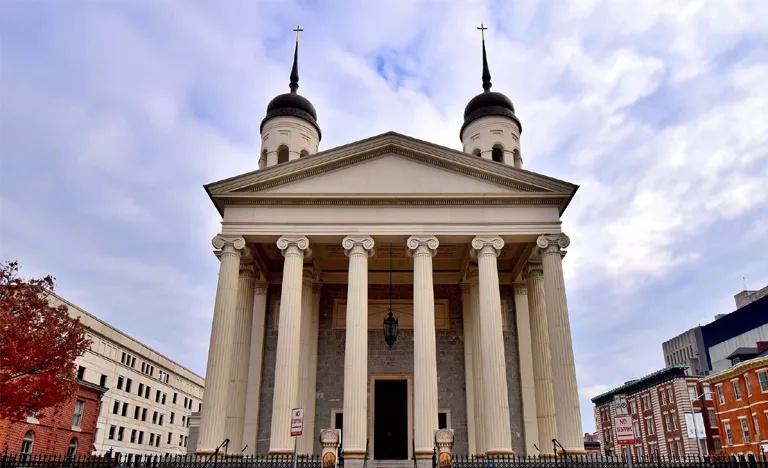
The first and oldest cathedral of the United States was built from 1806 to 1821 in Batimore, Maryland. Officially named the Basilica of the National Shrine of the Assumption of the Blessed Virgin Mary, this beautiful church was designed by John Carroll, the first Archbishop of Baltimore, his cousin Charles Carroll, signer of the Declaration of Independence, and Benjamin Henry Latrobe, architect of the U.S. Capitol Building.
The original plans to build it were initiated by the first Catholic bishop and archbishop in America, the Most Rev. John Carroll (1735-1815). He was a native-born American and a brother of a signer of the Constitution and a cousin of a signer of the Declaration of Independence. At that time when he served as the first ordinary of the first diocese in the nation, his territory encompassed all of the United States. Carroll’s family was well-known in the area; they had been instrumental in the development of the colony of Maryland and the establishment of the city of Baltimore in 1729.
Baltimore was chosen because Maryland was one of the few regions of the 13 colonies that had a substantial Catholic population. Before the United States declared its independence in 1776, Catholics in America were under the ecclesiastical jurisdiction of the Apostolic Vicariate of the London District in England.
In 1784 Pope Pius VI set up the Prefecture Apostolic of the United States, encompassing the entirely of the new nation, with Baltimore as its city. In 1789 the same pope erected the Diocese of Baltimore. The following year, Carroll traveled to England where he was consecrated a bishop in a castle by a Benedictine bishop. Upon his return, in the year 1800 the first native-born American citizen was ordained a priest in Baltimore at St. Peter’s Pro-Cathedral, built in 1770.
The Basilica was constructed between 1806 and 1863 to a design of Benjamin Henry Latrobe (1764-1820), America’s first professionally trained architect and Thomas Jefferson’s Architect of the U.S. Capitol. It is considered among the masterpieces of renowned architect Benjamin Henry Latrobe. The celebrated gneiss stone structure has been called the most provocative and influential building of its day due to its neoclassical design that includes a temple-front hexastyle portico, Delorme-inspired dome, Latin cross plan, and bold, clean detailing. Indeed, the Basilica was the first American church to break completely with the English-inspired Wren-Gibbs prototype that dominated religious architecture in this country during the seventeenth and eighteenth centuries.
The Basilica follows the model established by the Roman Pantheon, the most complete temple-fronted structure of ancient antiquity, for the modern use of classical motifs. It is also among the first to be built in a Latin cross plan. Here, Latrobe successfully married Catholic liturgical traditions with the bold rational geometry of the neoclassical style.
The construction of a cathedral in Baltimore was first envisioned by Father John Carroll, whom the Pope appointed Vicar General of the Roman Catholic Church in the United States and its first American Bishop (later elevated to Archbishop). For this reason, Baltimore is considered the birthplace of the Roman Catholic hierarchy in the United States. While Maryland was founded by the Carroll family as a haven for persecuted Catholics, for nearly a century prior to the American Revolution and the adoption of a new constitution, Catholics were not free to worship openly.
Bishop Carroll thus intended the Basilica to celebrate their newly regained freedom. Of the two designs that Latrobe presented, Carroll selected the neoclassical over the Gothic design generally associated with the old ecclesiastic architecture of Europe. Modeled after ancient Roman architecture and Republican ideals, the neoclassical design likely seemed to Carroll the appropriate choice for the first cathedral built within the new nation. When built, it laid just beyond the city grid, on the newly created Cathedral Street, an extension of the existing Liberty Street.
Latrobe is generally recognized as the father of the American architectural profession, although he had trained in his native England. Latrobe arrived to the United States in 1795, and like many before and after, brought with him knowledge of the latest architectural fashions from abroad. Few, however, obtained the success and acclaim that was Latrobe’s. As both an architect and engineer, Latrobe possessed unique knowledge and experience that provided competency in every aspect of building design and execution; he also possessed a creativity that was rarely matched. The Basilica of the Assumption is a perfect example of Latrobe’s application of these ideals. It was begun while Latrobe was at the height of his career and consecrated just after his untimely death in 1820.
The Basilica was blessed and opened for use on May 31, 1821, by the third Archbishop of Baltimore, Ambrose Maréchal. It was consecrated on May 25, 1876, by Archbishop James Roosevelt Bayley. Many famous events have occurred within its walls, including the funeral Mass of Charles Carroll of Carrollton, the only Catholic signatory of the Declaration of Independence. Carroll had been the last of the surviving signers. Most of the first American bishops were consecrated here to fill the ever-multiplying dioceses necessitated by the young country’s territorial expansion and the great growth of the American Catholic population. Until recent years, more priests were ordained at the Baltimore Basilica than in any other church in the United States.
The building hosted many of the 19th-century meetings that shaped the Catholic Church in America, including seven Provincial Councils and three Plenary Councils. Among other effects, these led to the founding of The Catholic University of America and efforts to evangelize African and Native Americans to Catholicism. The Third Plenary Council, which was the largest meeting of Catholic bishops held outside Rome since the Council of Trent, commissioned the Baltimore Catechism.
In 1862, while in Maryland during the Civil War’s Peninsula campaign, Union General Joseph Warren Revere (grandson of Paul Revere) visited the Basilica. General Revere was compelled to convert to Catholicism, and he did so despite the on-going war. On October 19, 1862, Reverend H. B. Coskery baptized Revere at the Basilica. Revere’s Holy Communion took place on October 26.
In 1937, Pope Pius XI raised the cathedral to the rank of Minor Basilica. It was listed on the National Register of Historic Places in 1969, and two years later was declared a National Historic Landmark. In 1993, the United States Conference of Catholic Bishops designated the Basilica as a National Shrine.
Many people deemed holy by the Catholic Church are associated with the Basilica, including the Servant of God Mother Mary Lange, Foundress of the Oblate Sisters of Providence, the first order for Catholic nuns of African-American descent; the Blessed Father Michael J. McGivney, founder of the Knights of Columbus, who was ordained at the Basilica in 1877 by Archbishop James Gibbons; and St. John Neumann, who is credited with founding America’s Catholic school system.
The Basilica has welcomed millions of visitors, including Pope John Paul II in 1995, Mother Teresa in 1996, and Ecumenical Patriarch Bartholomew I of Constantinople in 1997. The building has also been visited by at least 20 other saints or potential saints. Archbishop William E. Lori, Archbishop of Baltimore, celebrated the 200th anniversary of the dedication of the Baltimore Basilica on May 31, 2021.
Cardinal Pacelli, the future Pope Pius XII, paid a quick visit to the Basilica on October 21, 1936. He arrived in Baltimore by train from Washington, D.C. and made a one-day visit to the area. He was driven in a car to the Basilica where he knelt in prayer for several minutes before the main altar. He then visited the crypt to see the tomb of James Cardinal Gibbons, the second cardinal in American history, before driving north to visit St. Mary’s Seminary and University, the first Catholic seminary in the country. He then drove back to Baltimore’s beautiful Penn Station and departed by train to continue on his way to New York.
The red galero hat of Cardinal Gibbons can still be seen, suspended since his death, a reminder to pray for the response of his soul. There is a story behind this custom that arose in Europe, urging the faithful to pray for reposed members of the College of Cardinals; the tradition being that the cardinals’ hats are suspended in their cathedrals until their souls are eventually released from Purgatory, symbolized by when the hats decay after many years, falling in pieces to the floor.
In 1937 Pope Pius XI gave to the cathedral the rank of Minor Basilica shortly after Cardinal Pacelli’s visit and today it has the additional title of Co-Cathedral. A new cathedral for Baltimore was later built and was completed in 1959, dedicated to Mary Our Queen with a much larger seating capacity for 2,000 faithful on the north end of Baltimore. In 1960 Cardinal Montini (future Pope Paul VI) made a special visit to admire the “modern” architecture, a popular trend in those years.
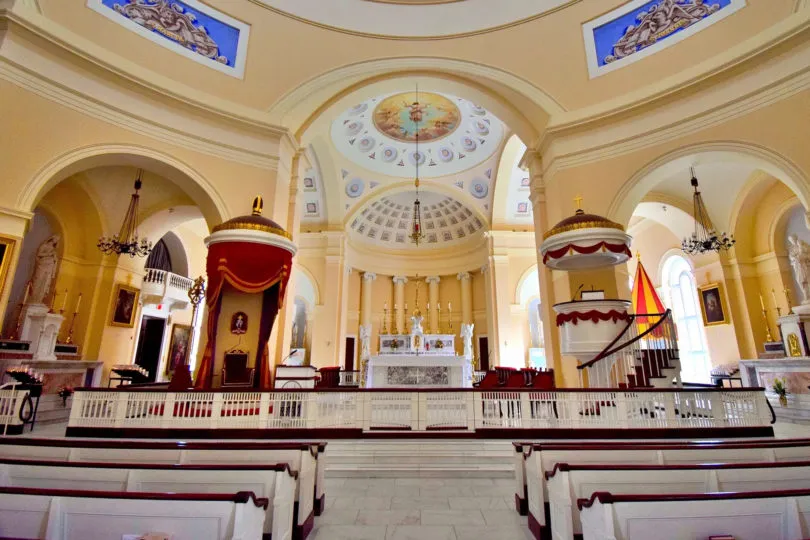
The cathedral is a monumental neoclassical-style building designed in conformity to a Latin cross basilica plan a departure on Latrobe’s part from previous American church architecture, but in keeping with longstanding European traditions of cathedral design. The plan unites two distinct elements: a domed space and a longitudinal axis.
As one of the first formally trained architects in the new nation, he was hired by Thomas Jefferson, a founding father and third president, who asked him to design the new U.S. Capitol building. Latrobe is also credited with the design of the neoclassical portico of the White House in Washington, D.C., reflecting in some ways what he was to later create at the Baltimore cathedral with its classical Greek portico of columns. For the Basilica, he arranged the columns in a double hexastyle pattern. The cathedral was completed after the architect’s untimely death, the result of yellow fever contracted in Louisiana.
While the Baltimore Basilica resembles a Roman temple from the exterior, on its roof it has two curious spires or cylindrical towers with onion-shaped domes that hold two bells. These resemble the former spires that once graced the rooftop of the Pantheon in Rome, reflecting in some ways the symbolic Christianization of the pagan architecture of old, making the old architecture distinctly Christian, with bells to sound the hours of prayer.
The interior design is occupied by a massive dome at the crossing of a Latin cross plan, adorned by grids of plaster rosettes. According to legend, Latrobe had originally planned for a typical masonry dome capped with a small lantern. But it was Thomas Jefferson who suggested a wooden double-shell dome of a type pioneered by French master builder Philibert Delorme. This version had 24 half-visible skylights. The light-filled interior was in sharp contrast to the dark and cavernous recesses of many traditional cathedrals in Europe.
The interior houses various works of precious art, including two paintings given by King Louis XVIII of France in 1821 just after the opening of the Basilica. In typical early nineteenth century heroic French style, the portraits depict the descent of Christ’s body from the cross as well as St. Louis IX burying his plague-stricken deceased troops in Tunisia during the Eighth Crusade, just before he, too, died in Carthage.
The massive dome at the crossing of the Latin cross plan, creating a centralizing effect which contrasts the exterior impression of a linear or oblong building. Surrounding the main dome is a sophisticated system of barrel vaults and shallow, saucer-like secondary domes. The light-filled interior designed by Latrobe was striking in contrast to the dark, cavernous recesses of traditional Gothic cathedrals.
The main altar was designed to be baroque in the style of southern Italy with two gradines and two different colored marbles with a unique acanthus flowering above the tabernacle, carved in Carrara stone, holding a golden altar crucifix that matches the six altar candlesticks. In addition there is also a rare mix of American heritage architecture, with confessionals in American colonial style, with large mullioned windows that allow ample light with single-pane clear window panels.
The principal feature of the main façade is a classical Greek portico with Ionic columns arranged in double hexastyle pattern, immediately behind which rise a pair of cylindrical towers. Architectural historian Henry-Russell Hitchcock believed that the onion-shaped domes atop the two towers were “not of Latrobe’s design,” but now it is believed that they “were entirely the architect’s own.”The exterior walls are constructed of silver-gray gneiss quarried from the Ellicott City Granodiorite.
The Basilica houses many precious works of art, including two heroic portraits: the first entitled Descent from the Cross by Pierre-Narcisse Guérin and the second, by Baron Charles de Steuben, depicts Louis IX of France burying his plague-stricken troops before the siege of Tunis at the beginning of the Eighth Crusade in 1270. Both portraits were gifts of King Louis XVIII of France shortly after the 1821 opening of the Basilica.
Latrobe originally planned a masonry dome with a lantern on top, but his friend Thomas Jefferson suggested a wooden double-shell dome (of a type pioneered by French master builder Philibert Delorme) with 24 half-visible skylights. For the inner dome Latrobe created a solid, classically detailed masonry hemisphere. Grids of plaster rosettes adorn its coffered ceiling.
21st-century restoration
A 32-month, $34 million restoration project was completed in 2006. The restoration included a total incorporation of modern mechanical systems throughout the building, while also restoring the interior to Latrobe’s original design. Many “misguided accretions” were corrected. The original wall colors (pale yellow, blue, and rose) were restored, as was the light-colored marble flooring which for decades had been a dark green color. Twenty-four skylights in the main dome were re-opened, and the stained glass windows (installed in the 1940s) were given to St. Louis parish in Clarksville (whose new church was designed around them) and replaced with clear glass windows.
Additionally, the Basilica’s crypt was made accessible to the public, as well as the expansive masonry undercroft (basement) of the church. The undercroft, until 2006, had been filled with sand from the original building of the cathedral, which prevented Carroll and Latrobe’s vision of a Chapel in the undercroft. During the restoration, the sand was removed, and the Our Lady Seat of Wisdom Chapel was finally realized.
Cardinal William Keeler, then Archbishop of Baltimore, and one of the many champions of the restoration project, completed the restoration without dipping into the coffers of the Archdiocese, instead using private funds donated for the sole purpose of the restoration. The Basilica was closed to the public from November 2004 through November 2006, reopening in time for the Basilica’s Bicentennial and the biannual meeting of the United States Conference of Catholic Bishops, which was held in Baltimore to mark the occasion.
2011 Earthquake
On August 23, 2011, an earthquake that jolted the East Coast from Georgia to Quebec rattled through the Basilica, sending nearly 1,000 linear feet of cracks through its ceilings and walls. A seven-month, $3 million restoration was completed on Easter Sunday 2012.
Notable interments
Nine of the fourteen deceased Archbishops of Baltimore have been laid to rest in the Basilica’s historic crypt. The crypt is located beneath the main altar, next to the Our Lady Seat of Wisdom Chapel, and is accessible to the public. Resting in the crypt are :
- John Carroll, S.J., first Bishop of the United States; Archbishop of Baltimore: November 6, 1789 – December 3, 1815
- Ambrose Maréchal, S.S., third Archbishop of Baltimore: July 4, 1817 – January 29, 1828
- James Whitfield, fourth Archbishop of Baltimore: January 29, 1828 – October 19, 1834
- Samuel Eccleston, P.S.S., fifth Archbishop of Baltimore: October 19, 1834 – April 22, 1851
- Francis Patrick Kenrick, sixth Archbishop of Baltimore: August 19, 1851 – July 8, 1863
- Martin John Spalding, seventh Archbishop of Baltimore: May 6, 1864 – February 7, 1872
- James Cardinal Gibbons, ninth Archbishop of Baltimore: October 3, 1877 – March 24, 1921
- Michael Joseph Curley, tenth Archbishop of Baltimore: August 10, 1921 – May 16, 1947 and first Archbishop of Washington: July 22, 1939 – May 16, 1947
- William Cardinal Keeler, fourteenth Archbishop of Baltimore: May 23, 1983 – July 12, 2007
Red Cardinal's hat
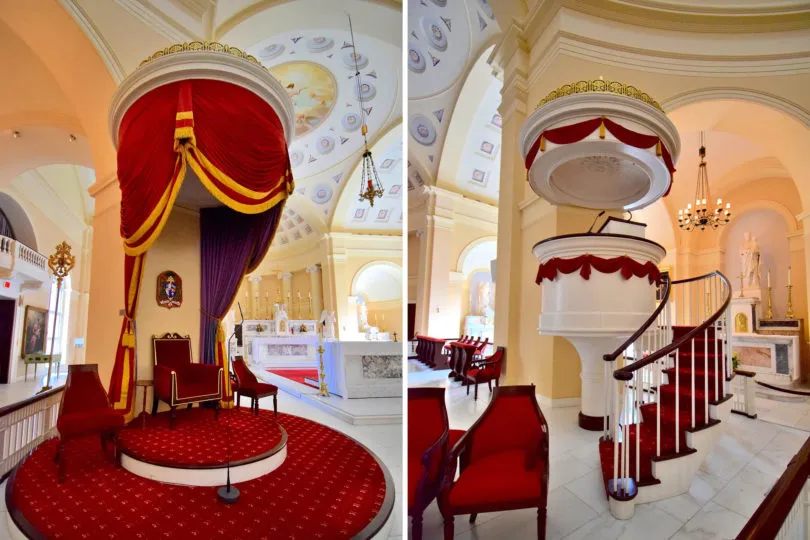
The red and gold baldachin, or umbrella that signifies this church is a basilica, but is that a HAT with tassles hanging from a hook on the wall? Yes indeed. It belonged to Cardinal James Gibbons, who served as Archbishop here from 1877 to 1921 and was ordained a Cardinal in 1886, at which time he was given this red Cardinal’s hat by Pope Leo XIII himself. Apparently, it is the custom to memorialize a Cardinal by suspending his hat in the Cathedral until the hat disintegrates. This one is almost 100 years old and appears to still be going strong. the owner of that hat is the first Bishop and Archbishop of Baltimore, John Carroll.
Paintings
There are two famous and very valuable paintings in the Baltimore Basilica, both gifts from the French king Louis XVIII in 1827. St. Louis Burying His Dead Soldiers by Charles de Steuben shows Louis XVIII’s predecessor, Louis IX, Saint, and King of France, burying his pestilence-stricken officers and soldiers in Tunis, Africa, in 1270.
The Descent from the Cross, eerily similar in style, colour, and layout to the painting above, is by Pierre Narcisse Guerin and shows Mary, swooning as she holds the body of her dead son, and surrounded by Joseph of Arimathea, Nicodemus, Mary Magdalene, and Mary the mother of James.
Famous though those paintings may be, the bronze by Kris Parmele entitled The Blessing, honouring of visit of Mother Teresa to this Basilica in 1996.
Statues
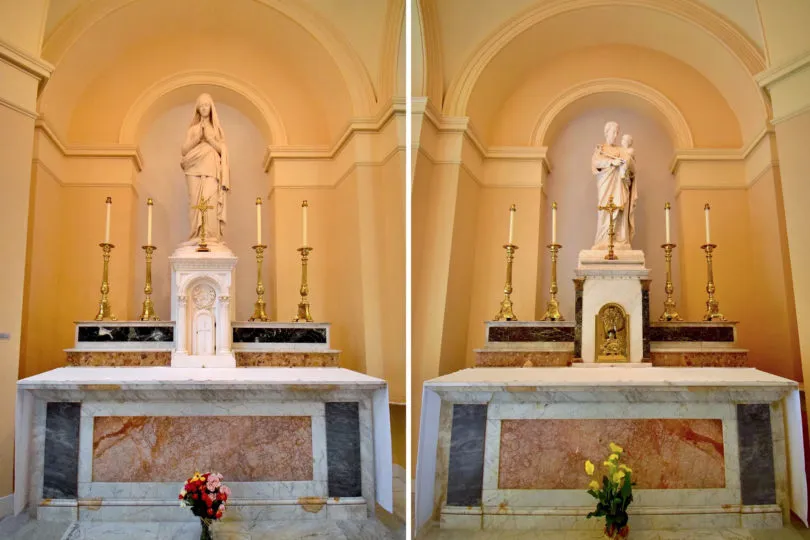
Niches around the Basilica perimeter held live-sized statues of Mary (placed here in 1821 and original to the Cathedral), and of Joseph with baby Jesus along with a nice pair of angels. Speaking of angels, check out these cherubs peaking out of the clouds at the very European-looking boy Jesus
In October 1995, Pope John Paul II knelt in this Basilica, which earned him his own permanent spot in the church. His friendly face and that unique staff/crucifix makes everyone to like him.
Basement
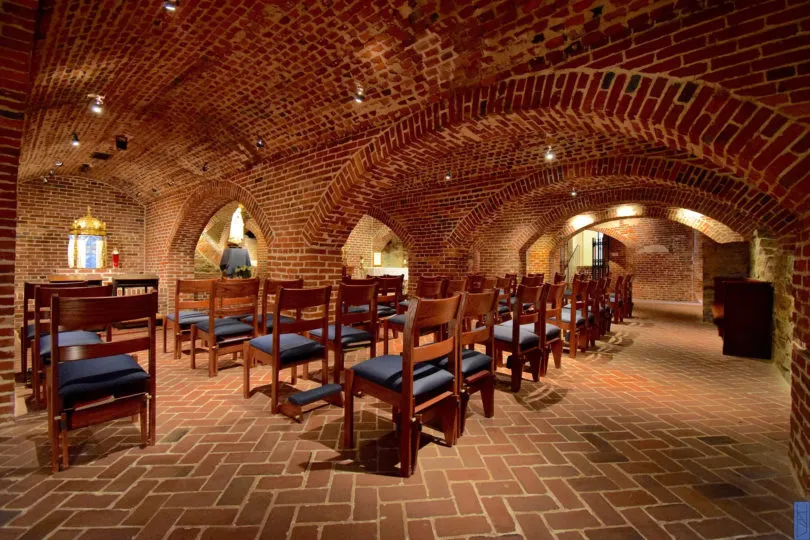
The best part of the Baltimore Basilica is the basement. During a 32-month restoration project completed in 2006, tons of sand were removed from the basement, and the Our Lady, Seat of Wisdom Chapel, part of Latrobe’s original vision for the basement, was created.
Arches and vaults are seen everywhere. Here is the Benjamin Latrobe, the great architect himself, watching over the underground chapel. One more fascinating, mind-boggling thing in this unique underground chapel is the use of inverted arches as part of the engineering.
One more “finished” room in the basement is used as a kind of Museum of Great People and Events. There are memorials to Father Michael J. McGivney (1852-1890), a American Catholic priest who founded the Knights of Columbus, and Mother Mary Lange (1784-1882), a free African-American who established the Oblate Sisters of Providence, a pathway for African-American women to enter into the religious life of the Catholic Church:
That photograph behind Father McGivney’s memorial are catchier. Taken in the early 1900s, it shows Cardinal Gibbons embracing his good friend Teddy Roosevelt, a frequent guest to the Basilica. A photo of Mother Teresa shows her speaking in the Basilica during her 1996 visit also placed here.
Annual Feast Day
Feast Day – 15th August
The solemnity of Assumption is the patronal feast day for the Basilica of the National Shrine of the Assumption of the Blessed Virgin Mary in Baltimore. The basilica will offer three Masses on the feast day: 7:30 am , 12:10 pm and 6:15 pm Following the 6:15 pm liturgy, the basilica will host an “Assumption party” on its lawn.
.
Mass Timing
Weekdays
- Monday : 7:30 AM (Crypt Chapel) ,12:10 PM (Main Church)
- Tuesday : 7:30 AM (Crypt Chapel) 12:10 PM (Main Church)
- Wednesday : 7:30 AM (Crypt Chapel) 12:10 PM (Main Church)
- Thursday : 7:30 AM (Crypt Chapel) 12:10 PM (Main Church)
- Friday : 7:30 AM (Crypt Chapel) 12:10 PM (Main Church)
Weekend days
- Saturday : 8:00 AM (Crypt Chapel) 1st Saturday 10:00 AM (Main Church)
- Sunday : 8:00 AM, 10:45 AM, 5:00 PM, 4:30 PM
Contact Info
409 Cathedral Street,
Baltimore, MD 21201,
United States.
Phone No.
Phone: 410-547-5523
Accommodations
How to reach the Sanctuary
Airways
The nearest airport to the Baltimore Basilica is Baltimore-Washington International Airport which is just 8 miles away from the basilica.
Railways
The closest railway station to the Baltimore Basilica is Lexington Market which is just a kilometre away from the basilica.

